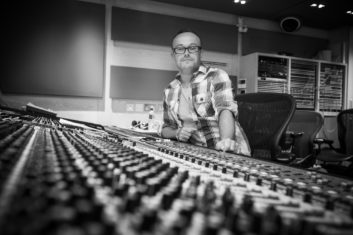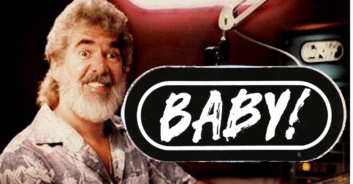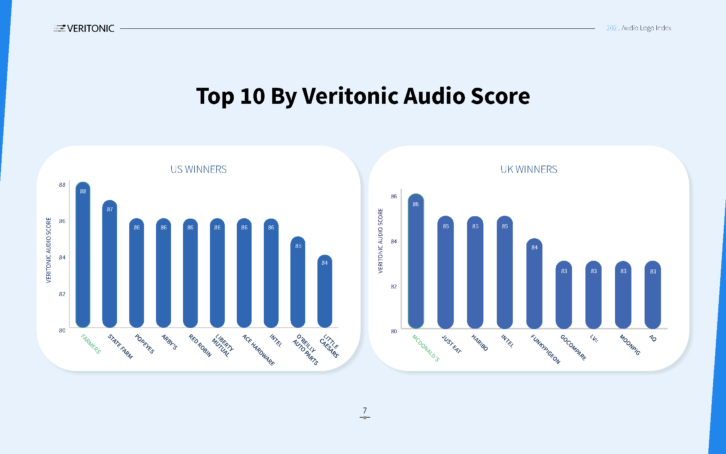For smart businesses, in a world where the selection of audio channels just keeps increasing, having a strong “audio logo” for branding purposes is more important than ever.
Whether it’s the distinctive three chimes long used by NBC (the musical notes G-E-C), McDonald’s short whistled melody or the choral “Liberty, Liberty, Liberty … Liberty” tag employed by the Liberty Mutual insurance company, the most effective audio logos stay in consumers’ minds.
Listeners just have to hear these short audio bursts to remember which brands the logos are referring to.
For the past five years, the audio intelligence firm Veritonic has ranked the most effective audio logos (as determined by AI-assisted measurement tools).
In 2021, Farmers Insurance had the highest ranked audio logo in the U.S., while McDonald’s was tops in the United Kingdom.
Make it stick
But the “2021 Audio Logo Index” — available for free download at www.audiologoindex.com — doesn’t just offer rankings by business sector: It also provides tangible advice on creating “sticky” audio logos — memorable, emotionally resonant, correctly associated with a brand.

“The value of saying your name has never been more obvious,” states the report. Equally as important is crafting audio logos that reflect the diversity of the target audience, so that consumers feel acknowledged and respected by the brands they’re listening to.
(One nice feature in this report’s downloadable PDF: It includes links to the audio logos being cited, so that readers can hear what Veritonic is writing about.)
Also worth noting: Sound and words together can be extremely effective in creating sticky audio logos.
“In particular, companies that combine melody and brand name repetitions score consistently higher on our audio logo rankings,” said Scott Klass, Veritonic’s SVP of marketing.
“This is why the Liberty Mutual audio logo does so well: They sing the brand name four times. Liberty is the poster child for audio logos that not only stay in your head, but help people know exactly which brand they’re hearing.”
Why they work
Dave Bethell is co-owner of TM Studios in Dallas, a 50-year-old company known for its work in radio branding jingles.

“We sing our first audio logo in the form of the alphabet song,” Bethell told Radio World. “There’s a reason why we learn music when we’re children. Combining words with music imprints in a different area of the brain than is used for spoken word memory. Our ability to remember music melodies and the words or messages associated with them is scientifically proven to be more effective than words alone, which is why memorable audio logos stick with us.”
When it comes to audio logos for radio, the most memorable ones reflect the stations that they are promoting.
“Audio logos that evoke the brand in a visceral way can be especially effective,” said Fred Jacobs, founder of Jacobs Media, which creates audio logos for its clients.
“San Francisco’s KOIT(FM) was famous for its audio logo, which used a cable car sound effect. This sounded evoked the San Francisco vibe very successfully, and it made you think of KOIT whenever you heard a cable car go by.”
Meanwhile, WRIF(FM) DJ Arthur Penhallow came up with the Detroit station’s signature slogan “Baby!” that became an audio logo in its own right. “Baby!” was so tied to WRIF that “it eventually made its way to bumper stickers and merch,” said Jacobs. “Whenever people thought of WRIF, they bellowed out a ‘Baby!’ imitating Art’s voice and exuberance.”
Making logos
Jacobs is a big believer in audio logos for radio stations. But it takes more than a choir singing the station’s call sign to make an audio logo memorable.

In fact, so many stations use this form of audio branding that it may be counterproductive to create audio logos in this manner.
So what does it take to make an effective audio logo for radio?
“The key to winning in radio — and for a brand — is capturing the consumer’s attention; better yet, getting inside her head,” he replied.
“To achieve this, the sound has to be memorable and evocative. It helps to have a regional or local hook too, and to offer something that is relevant to the target audience.”
The success of KOIT’s and WRIF’s audio logos were rooted in these principles. Today, a similar approach can be used by bringing together a short instrumental sting that aligns with the station’s music format, locally meaningful sound effects like KOIT’s cable car, and the station’s call sign and punchy slogan — ideally something witty that has caught on with listeners like WRIF’s “Baby!” rather than a vague marketing tag like, “Always with a better song!”
To determine which audio logos actually capture consumers’ attention, Scott Klass recommends leveraging consumer response data targeted within the station’s listening area to see which ones work best.
“Veritonic is a data analytics company, so naturally I suggest that people look at the data,” he said. “If you need ideas as to what specific elements work best in audio logos, I would refer to our 2021 Audio Logo Index.”
Results on a budget
Memorable audio logos don’t have to be expensive, said Bethell, as long as the content is unique, evocative and closely identifiable with the radio station being promoted.
He does recommend keeping audio logos short, because attention spans are shorter than they used to be.

“Back in the day, the radio industry used three-minute jingles where we’d sing all about the place where the radio station was from,” said Bethell. “Today, audio logos have to be very short because we want to get the listeners back to the music.”
As for radio executives who don’t think that audio logos matter?
“Whether you’re in a PPM or a diary market, consumers have to remember you — and then remember to listen or write you down,” Jacobs said.
“Sonic signatures can be that special identifier. Yes, there are other brand practices that are more comfortable and familiar to some executives because they’re more traditional, such as logo design, station voice and slogans. But in the age of smart speakers, when clear sound branding is more important than ever, standout audio logos are a must.”
Send your show news and updates to [email protected]
The post Audio Logos Are Powerful, in Radio and Beyond appeared first on Radio World.
